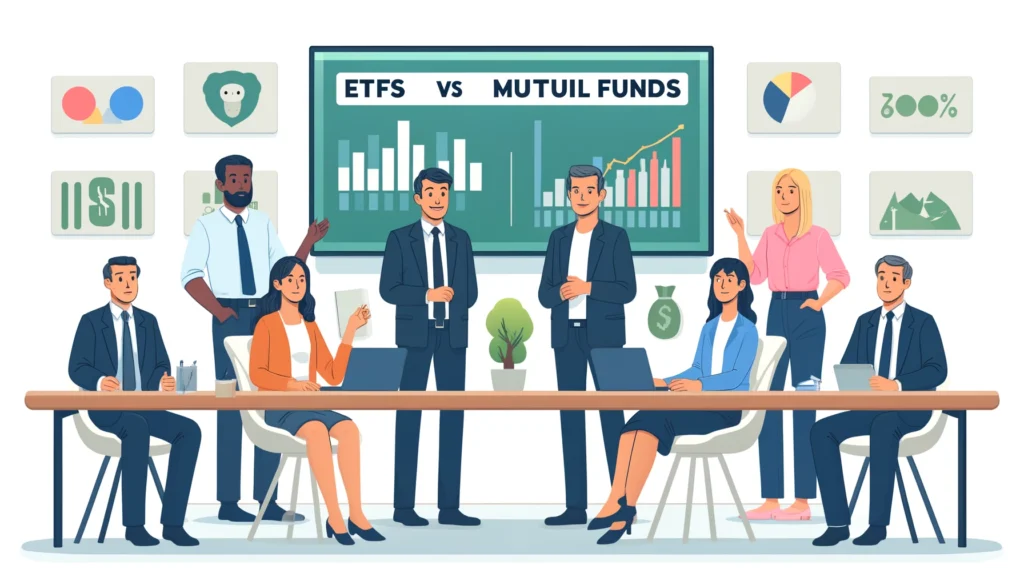사례 연구: ETF 대 뮤추얼 펀드

사례 연구: ETF 대 뮤추얼 펀드
사례 연구 학습 목표:
In this case study, users will examine the differences between ETFs and mutual funds, focusing on their benefits and drawbacks to make informed investment decisions.
사례 연구 개요:
사례 연구 정보:
David is a 45-year-old investor considering whether to invest in an ETF or a mutual fund for long-term growth. He wants to understand the key differences between these investment vehicles, including fee structures, performance, and how they are affected by market conditions.
가정적인 시나리오:
David is evaluating an ETF and a mutual fund, both of which track the same market index. He needs to assess the factors that will influence his decision, such as fees, liquidity, tax implications, and overall performance.
Part 1: Understanding ETFs and Mutual Funds
1부에 대한 정보:
ETFs (Exchange-Traded Funds) and mutual funds are popular investment vehicles, each with distinct characteristics, benefits, and drawbacks.
- ETF:
- Traded on stock exchanges like individual stocks.
- Typically have lower expense ratios compared to mutual funds.
- Offer intraday trading and greater liquidity.
- More tax-efficient due to their structure, leading to fewer capital gains distributions.
- 뮤추얼 펀드:
- Bought and sold at the end of the trading day at the net asset value (NAV).
- Often actively managed, which can result in higher expense ratios.
- May have minimum investment requirements and redemption fees.
- Can distribute capital gains, leading to potential tax liabilities for investors.
1부에 대한 질문:
- What are the key differences in fee structures between ETFs and mutual funds?
- How do the liquidity and trading features of ETFs and mutual funds differ?
Part 2: Evaluating Performance and Market Conditions
2부에 대한 정보:
Analyzing the performance of ETFs and mutual funds over time and under different market conditions provides insights into their potential for long-term growth.
Given the following data:
- A popular ETF (SPDR S&P 500 ETF – SPY) tracking the S&P 500 index had an average annual return of 10% over the past decade with an expense ratio of 0.09%.
- A mutual fund (Vanguard 500 Index Fund – VFINX) also tracking the S&P 500 index had an average annual return of 9.5% over the past decade with an expense ratio of 0.14%.
- During the last economic expansion, both SPY and VFINX performed well, closely following the S&P 500 index.
- During the last economic contraction, SPY experienced a decline of 30%, while VFINX also declined by 30%.
2부에 대한 질문:
- How did the performance of the SPDR S&P 500 ETF (SPY) compare to that of the Vanguard 500 Index Fund (VFINX) over the past decade, considering their expense ratios and average annual returns?
- How do market conditions affect the performance of ETFs and mutual funds, and what should investors consider during different market phases?
3부: 지식을 현실 세계에 적용하기
3부에 대한 정보:
Understanding real-world examples of ETFs and mutual funds’ performance can help David make an informed decision about his long-term investment strategy.
실제 세계의 예:
Comparison of a Popular ETF and a Mutual Fund:
- Popular ETF: The SPDR S&P 500 ETF (SPY) has shown consistent performance tracking the S&P 500 index with low expense ratios and high liquidity.
- Popular Mutual Fund: The Vanguard 500 Index Fund (VFINX) also tracks the S&P 500 index but has a higher expense ratio compared to SPY. However, it benefits from Vanguard’s strong reputation and management.
3부에 대한 질문:
- What factors should David consider when choosing between an ETF and a mutual fund for long-term growth?
- How can historical performance data guide David’s decision to achieve his long-term investment goals?
주요 시사점:
- ETF: Offer lower expense ratios, higher liquidity, and better tax efficiency, making them suitable for cost-conscious investors.
- 뮤추얼 펀드: Provide opportunities for active management and potential outperformance but come with higher fees and varying performance.
- 다각화: Both ETFs and mutual funds offer diversification benefits, but the specific holdings and management style should be considered.
- Historical Performance: Analyzing past performance helps inform investment decisions and manage expectations for long-term growth.
팁, 조언 및 모범 사례:
- 철저히 조사하다: Understand the characteristics, fees, and performance of both ETFs and mutual funds before making investment decisions.
- Consider Costs: Pay attention to expense ratios and trading costs to maximize net returns.
- Diversify: Spread investments across different asset classes and sectors to manage risk.
- Monitor Performance: Regularly review the performance of your investments to ensure they align with your long-term goals.
- Consult Professionals: Seek advice from financial advisors to tailor investment strategies to individual needs and goals.
마무리말:
Congratulations on completing this case study! By understanding the differences between ETFs and mutual funds and applying real-world examples, you have gained valuable insights into building a balanced and diversified investment portfolio. Keep researching, stay diversified, and focus on your long-term financial goals to achieve a successful investment journey. Happy investing!

